It was not easy for scientists to assess the physical conditions that existed in the first seconds after the Big Bang, because they are absolutely unbelievable from the point of view of the modern world. Moreover, this era is removed from us as far as 13.8 billion years. But the physical laws, particles, and radiation that emerged then had a tremendous impact on the further evolution of our Universe. So, by carefully studying its structure and patterns of development, we can gradually get to its fundamentals.

Imagine standing on the ruins of a very ancient city. All around you are ruins of ancient buildings, human remains, and household items. If you are a scientist in such a place, there is a high probability that you are an archaeologist. Every detail will be important to you — the location of objects relative to each other, the depth of the layer where they were found, the condition they are in. Now imagine people who are archeologists of the whole universe. Every star, galaxy, or cluster of galaxies is an ancient artifact, because our Universe is constantly moving and evolving in time. Such modern meta-archaeologists call themselves cosmologists. In this article, we will take a closer look at cosmology and go through the “archaeological layers” of our Universe — we will look at the stages of evolution that it has passed up to the current moment.
We will be traveling from the present time to the past, although it might be easier to understand if we walked in the opposite direction. And we will do so because the “deeper” the layer we touch, the less knowledge modern science has about it. Before we start, let’s recall a few facts that modern cosmology accepts as postulates. First of all, the speed of light, gravity, and any interaction or information is finite. This postulate, which Einstein laid down as the basis for the Special Theory of Relativity back in 1905, has been tested countless times by scientists and now they have no reasons to doubt it. Its direct consequence is that when we look into the distance, we look into the past. The further away the objects you observe, the older they are. The deepest past is the age of our Universe, which, according to the latest observational data, can be estimated as 13.8 billion years.
The second postulate is the cosmological principle. Cosmologists are convinced that, on average, there are no chosen points or directions in our Universe on a large scale. The cosmological principle states that there is no “navel of the world”, “center of the universe” or anything like that anywhere. On really large scales (hundreds of megaparsecs), the Universe will appear homogeneous and identical in any region and in any direction. For example, if you want to count how many galaxies are in the same volume of space, you will always get approximately the same number. And this is a true observational fact, although scientists are still debating on what scale such homogeneity occurs.
In addition, it’s worth remembering that everywhere in space and time, the laws of physics that drive the evolution of the universe are the same. This is another postulate that is generally accepted when building theories. Armed with these postulates, we take our seats in the time machine and travel back in time.
The modern era
If you look up at the sky on a starry night, you will see (though you may not necessarily notice) an important feature of the sky: darkness. This simplest observation shows that matter in the modern Universe is locally organized in a very heterogeneous way, forming small compact clumps (sometimes very dense) — planets, stars, clouds of gas and dust, and on a larger scale — galaxies. It took time for these structures to form from a much more homogeneous Universe of the past. In particular, for galaxies and the stars they consist of to start glowing, the gas must collapse under gravity and heat up enough to start thermonuclear reactions.
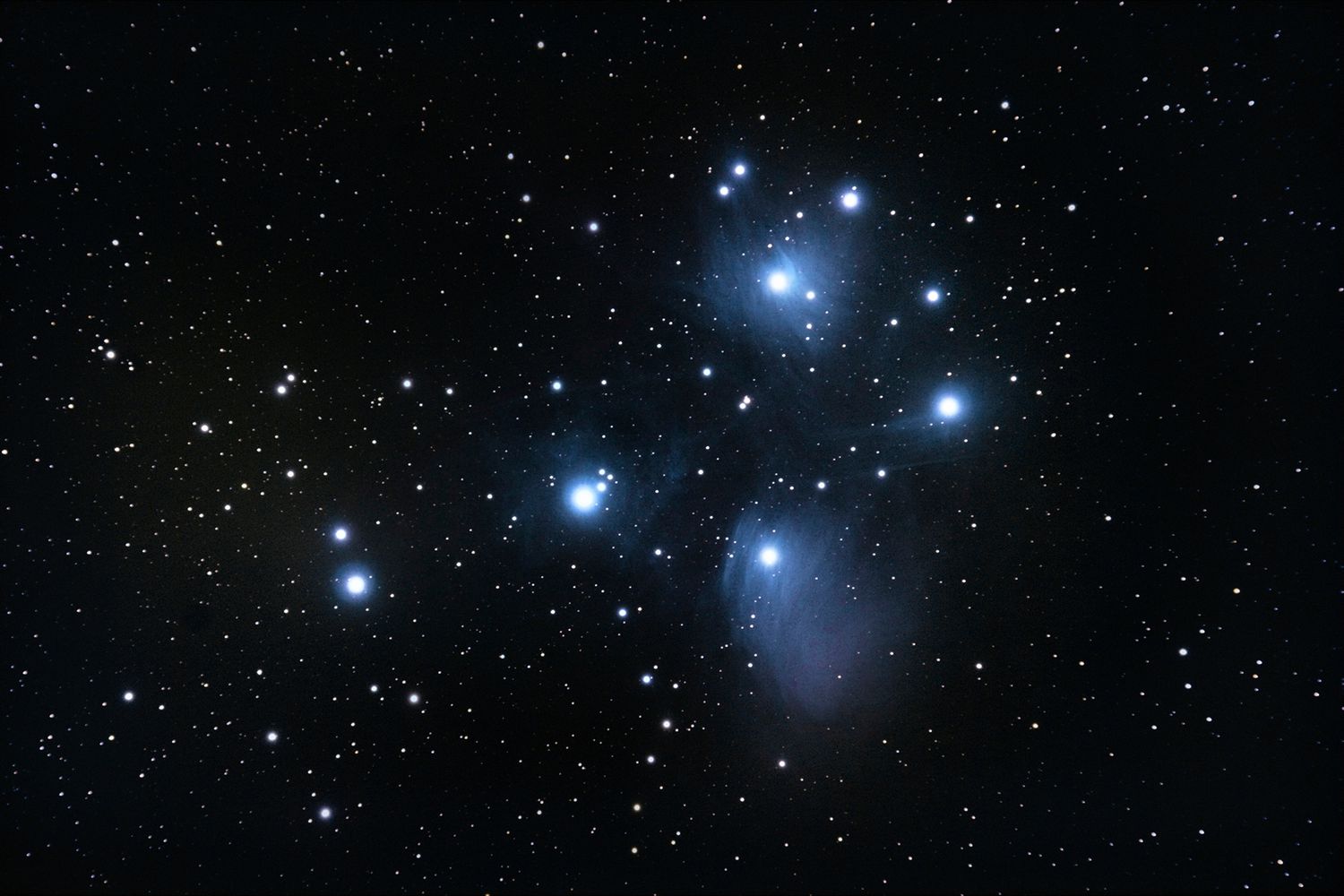
The first stars, formed from primordial hydrogen clouds, were lit between 200 and 500 million years after the birth of the Universe. The brightest of the newly formed galaxies, of which they were a part, can be observed using the James Webb Space Telescope.
Scientists believe that modern large-scale structures, such as galaxies and galaxy clusters, were formed from perturbations of the primary field (infatron field), which gave birth to all matter in the Universe. It primarily includes not only and not so much baryonic matter, which we all consist of and which can absorb and emit light, but also dark matter, which is 4-5 times more abundant than baryonic matter and which forms massive halos around visible structures. The evolution of each galaxy is unique in its own way: initially, they had different masses, developed in different environments, and could merge and absorb each other. But they also have some common features: all galaxies are slowly aging, “burning” hydrogen and helium into heavier elements in the bowels of their stars, and are passing the peak of their star formation. Their active nuclei, which are supermassive black holes with gas falling into them, gradually lose their activity, “clearing” the space around them. Together with intergalactic ionized gas, which makes up a significant part of visible matter, galaxies and galaxy clusters, as well as the dark matter that surrounds them, form an increasingly complex pattern in space — large-scale cosmic filaments, “walls,” and a system of cavities (voids). The entirety of these structures is now called the “cosmic web”. It, as well as the processes described here, characterize the current stage of the Universe’s evolution, which has another interesting feature: accelerated expansion due to the dominance of dark energy in its density — a mysterious substance or phenomenon whose “pressure” leads to such expansion.
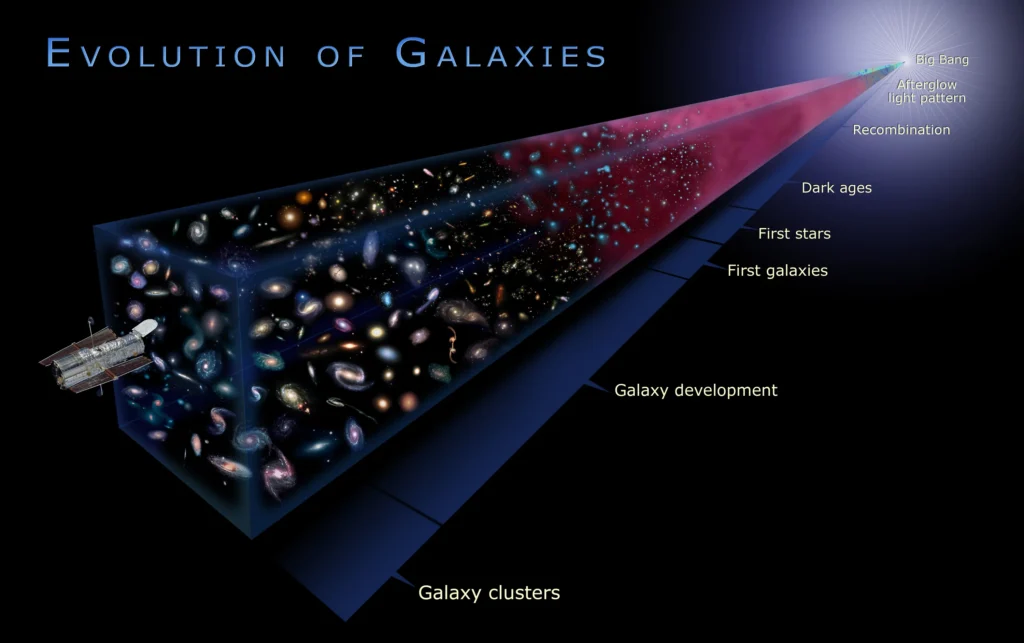
The era that preceded the modern one is called the Dark Ages in cosmology. And in this case, unlike the historical term, we can say that the name describes this era literally.
The Dark Ages and the Cosmic Dawn
The concept of the Big Bang, omitting the details, can be explained quite simply in a few words: the further back in time we go, the hotter and denser the Universe was. At some point, it becomes so dense and hot that it glows constantly, but at the same time remains opaque to its own light. This is somewhat similar to our Sun – we can see light only from its upper layer (the photosphere). The light of the Universe can also be seen – just at the moment when it is still hot enough to glow, but no longer dense enough to absorb all this light. After passing through billions of years of space expansion, this light has now turned into the microwave background, whose discovery in 1965 was the winning argument for the Big Bang theory. What happened between the appearance of this radiation and the light from the first stars?
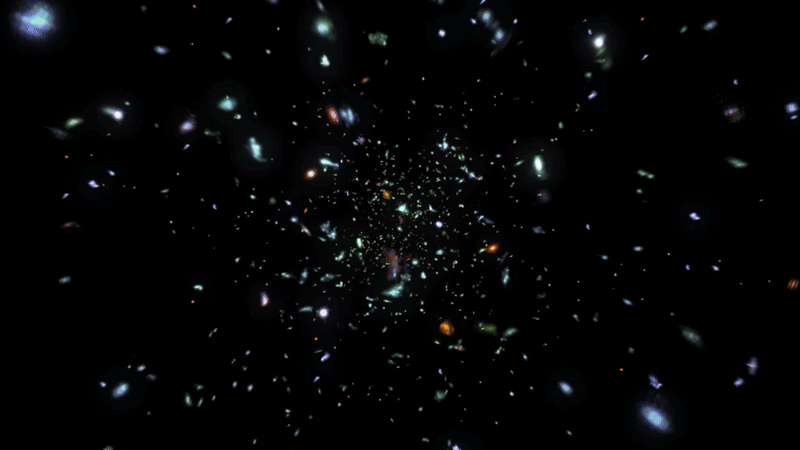
The matter perturbations that would later form galaxies have only just begun to collapse. It will take tens of millions of years for the gas density in them to become sufficient to start forming primordial luminaries. They won’t form quickly either, because the laws of conservation (including conservation of energy), known since school, do not allow it. The tighter gravity squeezes a protostar, the hotter it becomes. And the greater the pressure in its interior is, which resists further collapse. Thermal radiation saves them – it carries energy out of them and allows the pressure to increase until it becomes sufficient to “ignite” long-term thermonuclear reactions. The first stars could have been much more massive and brighter than today’s largest stars. They consisted only of hydrogen and helium – there were almost no other elements in the primary gas. What theorists miss is that some clouds collapsed directly into black holes (they were so massive), bypassing the phase of thermonuclear combustion. At the same time, cosmological reionization was taking place: the extremely high-energy radiation of these stars and the accretion disks of the first black holes pushed some of the gas out of the newly formed galaxies and ionized it. The process of the birth of the first luminaries was romantically called the Cosmic Dawn.
Recombination and primary plasma
Let’s look into an even earlier Universe. But this time we will have to look only with the power of thought: as you already know, when moving back in time, starting from a certain point, the Universe is opaque to light – it is too hot and dense. What was happening in this primordial plasma? It consisted of those elementary “bricks” of matter that every schoolchild knows about – electrons and protons. However, due to its very high temperature, hydrogen could not be formed from them: the kinetic energy of these particles was so high that the formed hydrogen atoms immediately split into protons and electrons again after hitting each other, leaving the plasma completely ionized. An important component was also the photons produced during ionization and re-emitted in the plasma. The expansion of the Universe gradually cooled it down: the amount of matter remained constant, while the volume grew steadily – until the moment called cosmological recombination. At this point, the plasma became so cold that protons and electrons recombined into hydrogen, and photons separated from the gas, reaching us as microwave radiation.
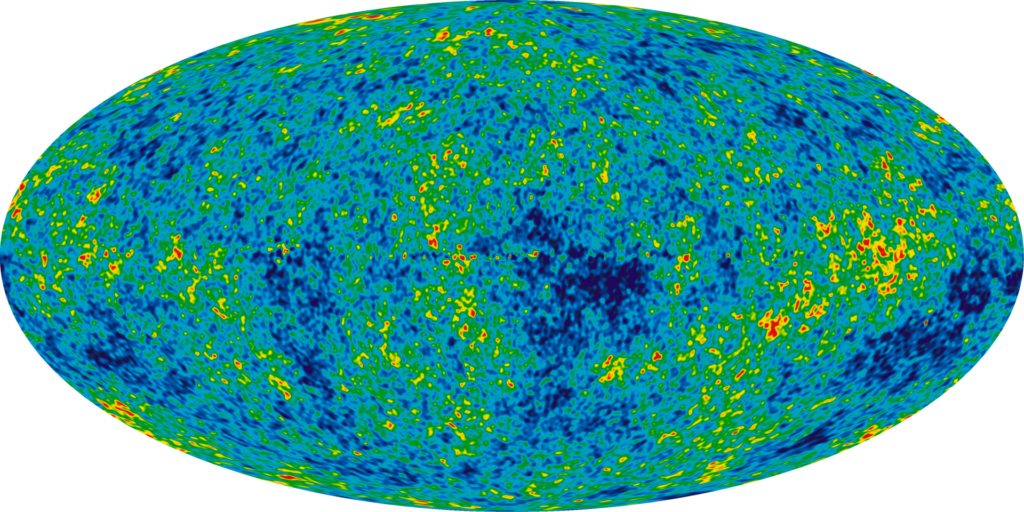
The approximate temperature of the Universe at which recombination was completed is 3000 kelvin, which happened 370 thousand years after its birth. The last scattering sphere is what scientists call the “snapshot” of our world that has come down to us since photons escaped from the primordial plasma. When they were born, these photons were mostly light, and the radiation had a typical spectrum of a completely black body, similar to the spectrum of the Sun, but more shifted to the red region. But the expansion of the Universe has made the wavelengths of this light about a thousand times longer, and now the peak of this spectrum falls on millimeter-wave radio waves, which can be “caught” by some television antennas.
Microwave relic radiation allowed us not only to prove the correctness of the Big Bang theory, but also to find out what exactly the Universe was like at that time. It turned out to be much more homogeneous than it is now, but even then there were inhomogeneities that began to grow from its birth. The data on the temperature inhomogeneity of the microwave background (and hence the magnitude of the perturbations at the time of recombination) made it possible to verify the presence of dark matter in our world, helped to estimate the cosmological parameters of the Universe with high accuracy and, accordingly, to restore the chronology of its evolution with a fairly accurate reference to time.
As already mentioned, the primordial plasma contained only hydrogen and helium. Their ratio was approximately three to one by mass, i.e., about 75% of the gas mass was hydrogen and 25% was helium. But where did the latter come from? It’s simple – it was born in thermonuclear reactions even earlier. Today we call them primary nucleosynthesis.
Primary nucleosynthesis
Thermonuclear reactions take place in the core of our Sun. Under a pressure of hundreds of billions of atmospheres and at a temperature of several million kelvin, the nuclei of hydrogen atoms – protons – can overcome the Coulomb barrier and get close enough to each other to form helium nuclei through a chain of reactions – two protons and two neutrons combined into one nucleus. As we move further into the past of the Universe, we inevitably come to a point where similar conditions existed. The primordial plasma was once so dense and hot that the kinetic energy of its protons was also sufficient to bring them closer together to start thermonuclear reactions.
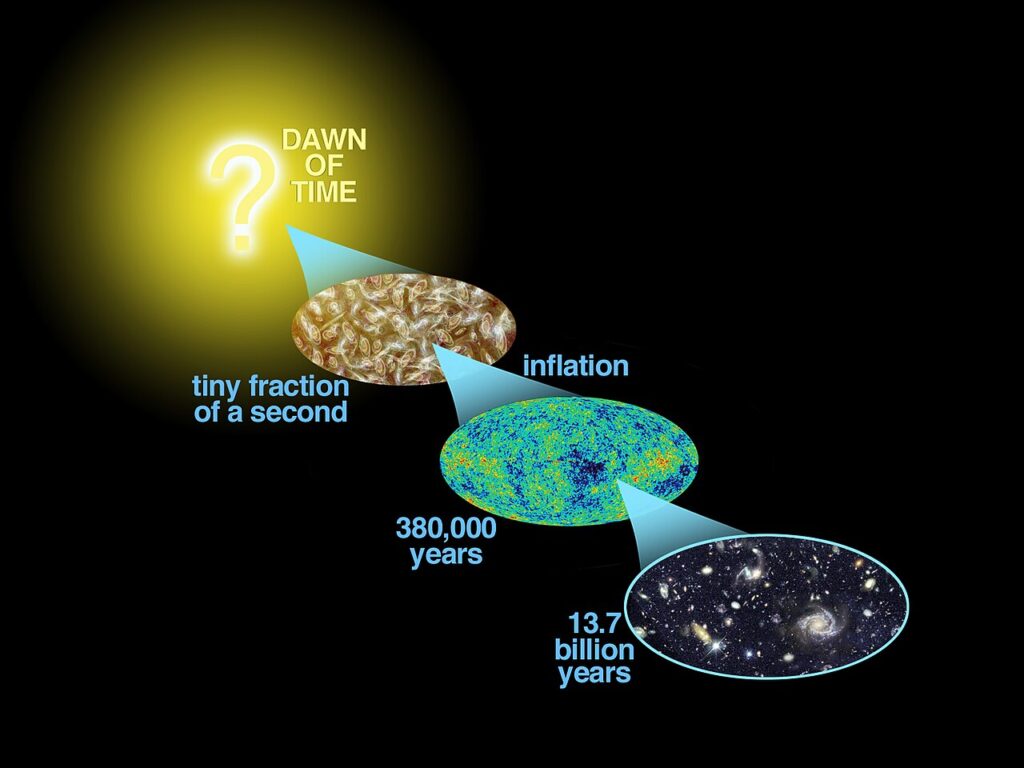
Primary nucleosynthesis took place for about the first twenty minutes of the Universe’s existence, starting from the moment when the existence of protons themselves became possible. As early as the 1950s, scientists, including Georgii Gamov, a native of Odesa, estimated how many and what kind of elements should have been produced as a result of such nucleosynthesis. They found that, being filled with only protons and neutrons, which decay rather quickly in the free state, the primary nucleosynthesis of the Universe should have produced exactly those almost 25% of helium, as well as small amounts of deuterium (an isotope of hydrogen whose nucleus consists of a proton and a neutron), helium-3 (an isotope of helium without one neutron), and lithium-7. This is a good time to recall our analogy between archaeology and cosmology. This time, the “artifacts” for cosmologists are the available chemical elements, or rather, their ratio in the primary plasma. Although the thermonuclear burning of stars gradually “contaminate” the primary ratios, scientists have managed to measure them quite accurately in the spectra of the oldest stars. And in general, the theorists were right! The research did not reveal any isotopes other than the ones mentioned, although they did notice that lithium-7 was much less abundant than expected. Eventually, an explanation was found: stars intensively “burn” this isotope. The ratio of elements after primary nucleosynthesis is currently the farthest observational information about the past of the Universe from us in time. Scientists can only theorize about everything else. And there is plenty to theorize about.
The first seconds of the Universe
The first ten seconds of the Universe were too hot even for nucleons, the particles that make up the nuclei of atoms. How hot was it then? As you know, it is quite easy to estimate the average speed of atoms and molecules at room temperature, which is several hundred meters per second. The thermal velocity of particles in the primary plasma, before the final formation of protons and neutrons, differed only by a very small fraction from the speed of light, which is unattainable for physical objects with non-zero rest mass.
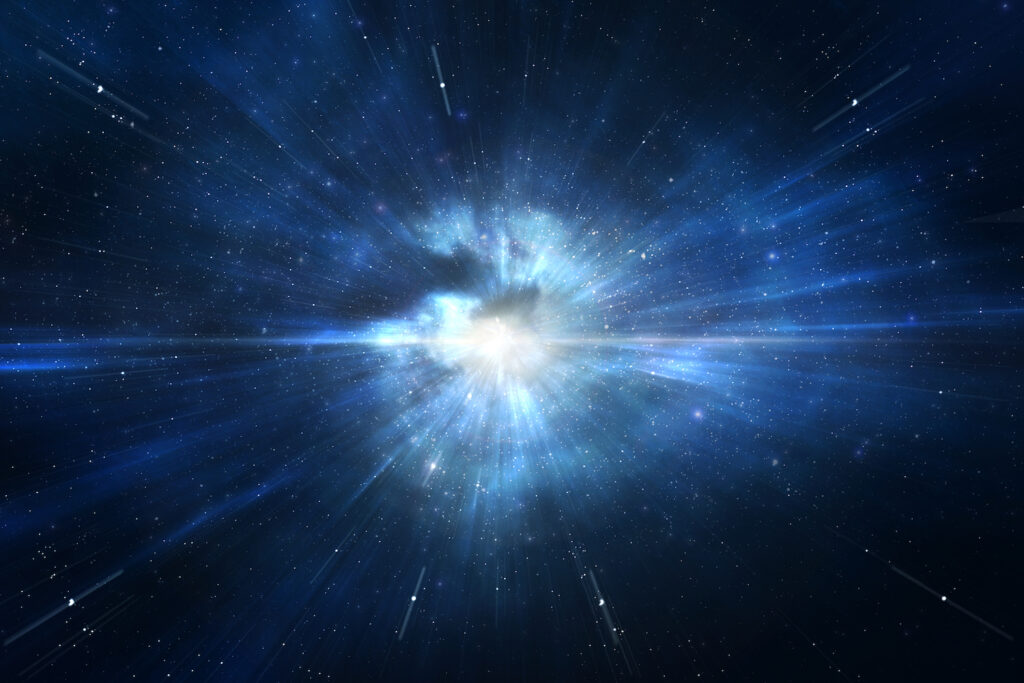
For example, a second after its birth, the Universe had a temperature of tens of billions of kelvin, a temperature that can still be found in the bowels of modern stars, even the most gigantic ones. At the moment of one ten-thousandth of a second, the temperature was a thousand times higher, and protons collided at speeds that can only be achieved in colliders. Under such conditions, their collisions lead to the birth of other elementary particles (e.g., pions), which have a very short lifetime but manage to interact in the extremely dense primary plasma before they disappear. Further movement into the past raises the temperature even higher and significantly expands the “zoo” of particles present. At some point (one millionth of a second after birth, a few quadrillion degrees Kelvin), matter enters the state of quark-gluon plasma, when there is so much ambient energy that even protons and other hadrons do not have time to form from interaction to interaction, and their components — quarks and particles that carry the interaction between them (gluons) — are already in equilibrium.
In the “pre-nucleosynthesis” era, other important events took place in the Universe. For example, somewhere in the first seconds of its life, it became transparent to neutrinos. And now it is filled with a relic neutrino background, similar to the microwave background, which has not yet been detected directly due to the insufficient sensitivity of modern instruments. Neutrinos are particles that interact weakly with other matter, but at some point the density was too high even for them. However, to understand all the details, you need to take a course in particle physics. Therefore, in this article, we have focused on the first fractions of a second of the Universe’s life. And from this material, you can learn about how its immediate birth took place.
Author: Maksym Tsizh, PhD in Physics and Mathematics, researcher at the Astronomical Observatory of Lviv University.
This article was published in #6(187) 2021 of Universe Space Tech magazine. You can buy this issue in electronic or paper versions in our store.


